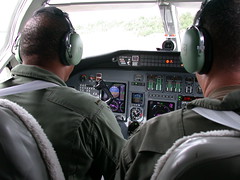Wednesday, 10 February 2010
Checklists in KM
I don't know if you have read the Checklist Manifesto? You ought to. It's extremely interesting for the KM professional. I read it recently, and something clicked for me as I went through it. It answered a question I have been struggling with for a long time - which is, how do we get knowledge back out into the organisation?
Identifying new knowledge is relatively easy. Updating practice, as a result of new knowledge, is not too hard either. Getting people to change their behaviour as a result is extremely difficult.
But listen to this story.
17th Jan, 2008, Times Online “Passengers aboard the BA38 from Beijing were reflecting on their lucky escape, after all 136 were safely evacuated when the stricken aircraft tore into the tarmac. Only three suffered minor injuries. A formal investigation is under way to find out what led one of the safest aircraft in the world to crash land at Heathrow airport this afternoon”.
13 May 2008, London Evening Standard “The British Airways plane that crash landed at Heathrow may have suffered from "fuel freeze" caused by cold weather, according to investigators. First Officer John Coward was forced to glide the Boeing 777 to safety after both engines failed at 600ft on flight BA38 earlier this year. The Air Accident Investigations Branch (AAIB) interim report into the incident on 17 January has indicated a drop in temperature to -76C (-105F) while flying over Russia may have caused the fuel to thicken, depriving the engines of the additional thrust needed to land”.
As a result of this investigation, new knowledge was created - How to stop ice forming in the fuel on polar flights, and how to recover flight control if icing causes engine failure (counter-intuitively – you cut the throttle instead of increasing it. This allows the heat of the engine to melt the ice and restore the fuel flow).
New knowledge.
And how long do you think it took for every 777 pilot in the world to update their flight practices with this new knowledge?
According to Atul Gawande, author of the Checklist Manifesto, it took 30 days.
Only 30 days for every 777 pilot in every airline in every country in the world.
How long does it take your company to incorporate new knowledge? 30 weeks? 30 months? Atul reckons that a new surgical procedure, in contrast, takes 17 years to be globalised. The difference is that pilots codify everything they know into checklists. They share them widely, and use them rigourously.
Most jobs nowadays are incredibly complex. The human brain can only remember so much at one time, and suffers easily from overload. Most mistakes are made, not because we don’t know what to do, but because we forget (or skip) a crucial step, especially in emergency situations. We need to be reminded of what we know, and what we need to remember. Checklists force us to stop and review, remind us of what needs to be done, take us through the critical steps, ensure we remember the right things, ensure we ask the right questions, and ensure we have the right conversations. And updates in checklists as a result of new knowledge, can remind us to do new things.
Atul has some fascinating stories to tell of introducing checklists into hospital surgery theatres, the pushback that he received and the difficulties that he met, but also the remarkable improvements in patient safety statistics that were made as a result.
However here's an anecdote to close out our story.
November 26, 2008, Delta Airlines from Shanghai to Atlanta.
39,000 ft above Montana the flight crew experienced “uncontrolled rollback of the right engine” due to ice in the fuel line. The pilot and co-pilot followed the revised checklist, the engine restarted, and none of the 247 passengers knew that anything unusual had happened.
That's effective learning in action.
Subscribe to:
Post Comments (Atom)





3 comments:
Thank you! Very useful article.
Hi I am James Truman the Lead for the Weapons Loading Standardization Team at NAWCWD China Lake. My team writes all the weapons loading and release and control checklists for Navy and Marine Corps Aviation. Great article and I will ensure my entire team reads this article and passes it on to our customers.
Thanks James
Post a Comment